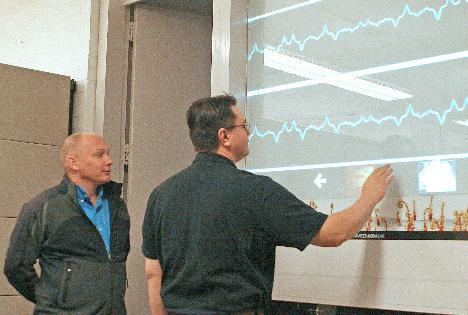Occasionally, movies do a good job of envisioning future technologies.
“Minority Report” got it about right with its depiction of future interface design. Tom Cruise stands at a giant display screen and slings information around with gestures of his gloved hands.
Efficient, intuitive and stylish.
Companies like Apple and Microsoft are making strides toward the realization of that kind of interface.
Microsoft Surface, a tabletop touch-screen that accepts input from several people at once, is due to for release in Spring 2008.
Apple has already begun selling advanced interfaces in their iPhone and iPod touch. Their screens can register two fingers independently for moving and scaling photographs and cycling through music.
But professors on campus are making their own contribution to the advancement of interfaces and new media.
Robert St. Amant, a computer science professor, once hacked together a tabletop interface that allowed users to manipulate colors and shapes with special gloves under an overhead projector.
He said that good interface design involves “exploiting people’s knowledge of the physical world,” and their understanding of spatial relationships.
St. Amant said he began a collaboration with Patrick FitzGerald from the College of Design.
FitzGerald uses a studio in Brooks Hall where he has assembled two additional working prototypes of advanced interfaces.
Both use infrared cameras to find hands and interpret gestures.
One system allows users to sweep through a line of student animations and play one with a touch. It uses an image projected from behind a large sheet hung in a window. The camera looks down from above to measure the angle of contact.
The other displays infrared images of the user’s hands and sends a school of fish after them. It uses a mirror in a wooden framework on the ceiling to direct a projection downward to the floor.
While they are little more than proofs of concept, FitzGerald said he views his work as a “very natural step forward,” while stressing the benefits of simplicity, scalability and an open-source culture.
Lee Cherry works with FitzGerald as the manager of the advanced media lab. He said the possibilities of the technology were a “new-media mashup.” They foresee applications in information design, entertainment design and gaming.
FitzGerald said museums in particular could benefit from such “augmented reality” displays. He says it would be a good incentive for youth accustomed to interactive information.
Although she said she likes museums anyway, Laura Morton, a freshman in English, said she welcomes the technology, “as long as it’s practical and there aren’t bugs in it.”
Gene Smilek, a freshman in mechanical engineering, said he’d be “anxious to try it out.”
There will be a chance to see these proofs of concept Dec. 7, at 7 p.m. in Kamphoefner Hall.
Thanks to a grant from the N.C. Arts Council, FitzGerald’s team will eventually install a display in a New Bern storefront.








